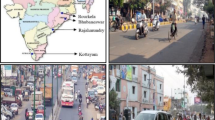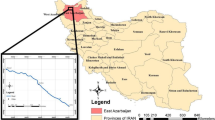Abstract
This article proposes a bicycle level of service (BLOS) model for the assessment of urban roadway segments in mid-sized cities carrying heterogeneous traffic. The bicycling environments persisting on as many as 74 segments of four Indian cities are thoroughly analyzed. On-street bicyclists with varied demographics have rated these segments using a Likert scale ranging from ‘1’ (excellent) to ‘6’ (worst). The influences of various road attributes (geometric, traffic, and built-environmental) and bicyclists’ characteristics (socio-demographic and travel characteristics) on the perceived ratings are assessed using Spearman’s correlation analysis. Subsequently, eight significant variables are identified and used to develop a Levenberg–Marquardt neural network-based BLOS model. The most efficient but less complex model consisted of one hidden layer, three hidden neurons, and hyperbolic tangent activation function. This model produced very high values of correlation coefficient between the actual and predicted perceived ratings (i.e., 0.93 and 0.92 in the training and testing phases, respectively). The applications of Garson’s algorithm and connection-weight approaches explored that the effective width of outermost lane has the highest influence on urban street BLOS. The BLOS criteria are classified into six categories A–F (representing excellent–worst) using the self-organizing map in artificial neural network cluster technique. It was observed that most of the studied segments are offering average to worst kind of services at their present-day conditions. Thus, the influencing variables should be largely prioritized in the planning process to achieve better service levels efficiently.


Similar content being viewed by others
References
Beura SK, Bhuyan PK (2017) Urban road segment level of service based on bicycle users’ perception under mixed traffic conditions. J Traffic Transp Engg 4(6):503–521. https://doi.org/10.1016/j.jtte.2017.02.003
Beura SK, Chellapilla H, Bhuyan PK (2017) Urban road segment level of service based on bicycle users’ perception under mixed traffic conditions. J Mod Transp 25(2):90–105. https://doi.org/10.1007/s40534-017-0127-9
Caliński T, Harabasz J (1974) A dendrite method for cluster analysis. Commun Stat 3(1):1–27. https://doi.org/10.1080/03610927408827101
Chellapilla H, Beura SK, Bhuyan PK (2016) Modeling bicycle activity on multi-lane urban road segments in Indian context and prioritizing bicycle lane to enhance the operational efficiency. In: Proceedings of the 12th transportation planning and implementation methodologies for developing countries (TPMDC) conference, IIT Bombay, Mumbai, India
Davies DL, Bouldin DW (1979) A cluster separation measure. IEEE Trans Pattern Anal Mach Intell PAMI. https://doi.org/10.1109/TPAMI.1979.4766909
Davis J (1987) Bicycle safety evaluation. Auburn University, City of Chattanooga and Chattanooga-Hamilton County Regional Planning Commission, Chattanooga
Davis J (1995) Bicycle test route evaluation for urban road conditions. In: Transportation congress: civil engineers—key to the world infrastructure 1 and 2, American Society of Civil Engineers (ASCE), San Diego, CA:1063–1076
Dunn JC (1973) A fuzzy relative of the ISODATA process and its use in detecting compact well-separated clusters. J Cybern 3(3):32–57. https://doi.org/10.1080/01969727308546046
Epperson B (1994) Evaluating suitability of roadways for bicycle use: toward a cycling level-of-service standard. Transp Res Rec 1438:9–16
FDOT (Florida Department of Transportation) (2009) Quality/level of service handbook. Florida Department of Transportation, Tallahassee
Goh ATC (1995) Back-propagation neural networks for modeling complex systems. Artif Intell Eng 9(3):143–151
Harkey DL, Reinfurt DW, Knuiman M, Stewart JR, Sorton A (1998) Development of the bicycle compatibility index: a level of service concept. Transp Res Rec 1636:13–20. https://doi.org/10.3141/1636-03
Highway Capacity Manual (2010) Transportation Research Board, Washington, D.C., p 1650
IRC (Indian Road Congress) (1990) Guidelines for capacity of urban roads in plain areas. In: IRC: 24 106. Indian Road Congress, New Delhi
Jensen SU (2007) Pedestrian and bicyclist level of service on roadway segments. Transp Res Rec 2031:43–51. https://doi.org/10.3141/2031-06
Landis BW (1994) Bicycle interaction hazard score: a theoretical model. Transp Res Rec 1438:3–8
Landis BW, Vattikuti VR, Brannick MT (1997) Real-Time human perceptions: toward a bicycle level of service. Transp Res Rec 1578:119–126. https://doi.org/10.3141/1578-15
Milligan GW, Cooper MC (1985) An examination of procedures for determining the number of clusters in a data set. Psychometrika 50(2):159–179. https://doi.org/10.1007/BF02294245
Mozer D (1994) Calculating multi-mode levels-of-service. International Bicycle Fund, Seattle
Olden JD, Jackson DA (2002) Illuminating the “black box”: understanding variable contributions in artificial neural networks. Ecol Model 154(1–2):135–150. https://doi.org/10.1016/S0304-3800(02)00064-9
Rousseeuw PJ (1987) Silhouettes: a graphical aid to the interpretation and validation of cluster analysis. J Comput Appl Math 20:53–65. https://doi.org/10.1016/0377-0427(87)90125-7
Rumelhart DE, Hinton GE, Williams RJ (1986) Learning internal representation by error propagation. Parallel distributed processing 1. MIT Press, Cambridge, pp 318–362
Sorton A, Walsh T (1994) Bicycle stress level as a tool to evaluate urban and suburban bicycle compatibility. Transp Res Rec 1438:17–24
Acknowledgements
The authors acknowledge the opportunity provided by the 4th Conference of the Transportation Research Group of India (4th CTRG) held at IIT Bombay, Mumbai, India between 17th December, 2017 and 20th December, 2017 to present the work that forms the basis of this manuscript.
Author information
Authors and Affiliations
Corresponding author
Rights and permissions
About this article
Cite this article
Beura, S.K., Manusha, V.L., Chellapilla, H. et al. Defining Bicycle Levels of Service Criteria Using Levenberg–Marquardt and Self-organizing Map Algorithms. Transp. in Dev. Econ. 4, 11 (2018). https://doi.org/10.1007/s40890-018-0066-0
Received:
Accepted:
Published:
DOI: https://doi.org/10.1007/s40890-018-0066-0




